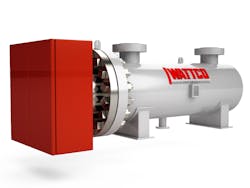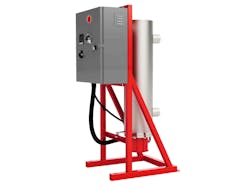Immersion heaters can be used to raise the temperature of water and chemicals. Immersion heaters are placed into a liquid to directly heat it. This causes evaporation or keeps a specific temperature consistent. Regardless, fluids must be contained in an enclosed space such as a tank or a container.
The most common applications for electric immersion heaters are:
- Heating chemicals to activate and be used in industrial operations
- Heating crude oil, fuel oil and hydraulics oil to maintain its viscosity
- Maintaining an oil temperature for pipeline transportation
- Heating water
- Keeping wastewater from freezing
This article will examine the role of immersion heaters in the process of wastewater management.
To ensure its supply is not diminished, water that has been wasted or made unusable is treated and managed through an elaborate system that cleans the water to make it safe and secure to be reused or channeled into a nearby river.
The number and types of wastewater immersion heaters in the market today are many. They keep wastewater from freezing during storage and use. Freezing can choke systems and cause incoming water to overflow.
Immersion heater types
A vertical circulation heater
Only a few heaters are effective in wastewater management use. The two most effective varieties are:
Screw plug heaters
These electric screw plug immersion heaters are also called threaded immersion heaters. In a unique design, heating elements are welded or brazed into a screw plug, which calls for a specific use. The heater is screwed into the container it will heat, and is chosen based on variation in sizes, voltages, sheath materials and kilowatt ratings.
Flanged immersion heaters
A flanged immersion heater features a complex structure, including tubular elements are bent beforehand and brazed or welded, and a wiring box is installed on the heater for electrical connections.
Unlike screw plug heaters, flanged units are installed by bolting to a welded flange. This can be done in the tank where the water is being stored or at the nozzle of the container where the liquid comes out of the container. The flanged immersion heater is also available in a variety of shapes, sheath materials, sizes, kilowatt rating and voltages.
Flanged immersion heaters are often chosen to heat liquids under high pressure from gaseous elements that can damage the heater in operation. Easy to install and maintain, these heaters directly immerse into the liquid and waste little heat.
Adapting to wastewater management
Immersion heaters prevent catastrophes. The generation of flammable or explosive gases that are stored in wastewater and released during the management process can be dangerous. These gases harm the heater, the heating element and the system as a whole.
However, electric immersion heaters can negotiate notorious chemical gases and chemicals such as acids, fluorides and chlorides. During wastewater management, water can be heated, turned into a vapor and condensed later. Evaporating the water leaves behind the toughest gases in liquid and chemical forms.
To make sure that heating elements continues to function without corrosion, heaters have a quartz or titanium makeup with an added polytetrafluoroethylene coating to protect it. In closing, it is worthwhile to note that wastewater coming from metal finishing tanks is the most dangerous because it contains so much phosphoric and sulfuric acids.
Ilan Toledano is a vice president of WATTCO, a manufacturer of electric heating elements and controls.

